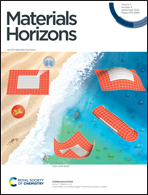From supramolecular to solid state chemistry: crystal engineering of luminescent materials by trapping molecular clusters in an aluminium-based host matrix†
Abstract
Programming the supramolecular association of well-defined metal-based inorganic aggregates of different natures is an innovative concept to design materials. The emergence of such a strategy requires the mastering of (i) the handling of metallic aggregates in solution and (ii) the control of dynamic and subtle interactions (hydrogen bonding, electrostatic, van der Waals forces) at the nanoscopic scale. Herein, we report an appealing procedure, where γ-cyclodextrin (CD) is used as a host–guest stabilizing agent and structural linker, to organize luminescent molybdenum clusters [Mo6Xi8Cla6]2− (X = Br and I) within well-ordered structures obtained from aqueous solutions. Such an approach enables the integration of the highly luminescent [Mo6Ii8Cla6]2− clusters within the inert supramolecular architectures built-up from CD and aluminium oxo-hydroxo-aquo-clusters [Al13O4(OH)24(H2O)12]7+ (noted {Al13}7+), which are optically silent in the absorption and emission spectral range. The charge is counter balanced by five Cl− anions. Interactions between clusters, CD and Cl− on one hand, and interactions between polycations and Cl−, on the other hand, lead to pseudo super-tetrahedrons {[Mo6Ii8Cla6]@2CD}Cl4 and {Al13}Cl4, respectively, that share apices. This results in an open framework whose structure is related to that of lithium aluminosilicate LiAlSiO4 (aka β-eucryptite). Compared to the usual cluster based compounds where the counter cations are alkalis or ammonium derivatives, in {Al13}{[Mo6Ii8Cla6]@2CD}Cl5·60H2O, the number of clusters per unit cell volume dramatically decreases but their luminescence is not quenched. Indeed, the hybrid material shows excellent luminescent properties in the red-near infrared region with a quantum yield of 26%.



 Please wait while we load your content...
Please wait while we load your content...